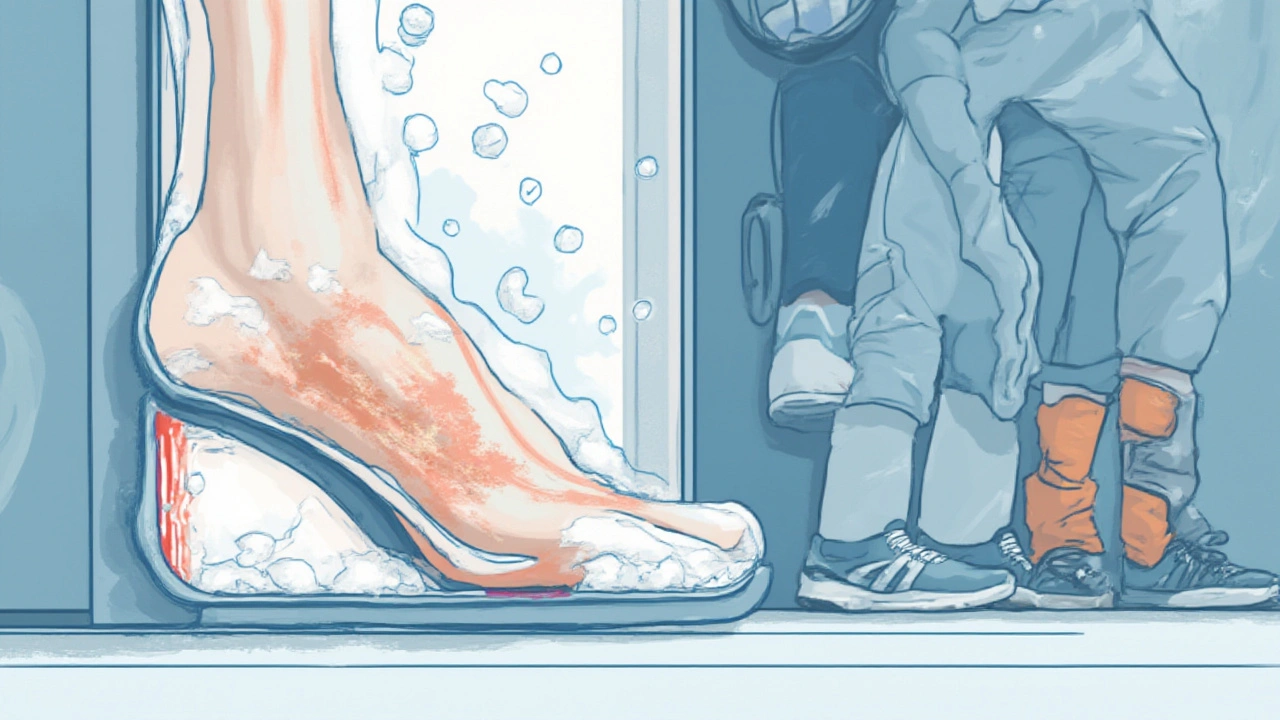Pop quiz: Have you ever glanced down at your feet after a big bowl of ramen or a salty snack fest and thought, "Wait, were my shoes this tight five hours ago?" Most people don’t realize just how quickly a salty meal can transform their ankles and toes into puffy versions of themselves. It’s not just your imagination—or guilt over an extra order of fries. There’s real science behind those post-sodium sausage toes.
The Science Behind Salty Meals and Foot Swelling
Your body runs on an incredibly delicate balance of fluids. Eat too much sodium—hello, pizza night!—and suddenly this balance goes haywire. Sodium attracts water, like that one friend who can’t turn down a party invitation. When you eat food loaded with salt, your bloodstream holds onto extra water to dilute the sodium and keep your blood chemistry just right. Your kidneys scramble to flush out the extra, but if they can’t keep up, fluid leaks from blood vessels and winds up in your feet, ankles, and sometimes even your calves. Gravity doesn’t help; it basically drags fluid to the lowest spot, which is why your feet are target number one.
Ever noticed how swelling gets worse as the day drags on? That’s gravity, too—especially if you’re standing or sitting for long stretches. So, if you’re munching on chips while binge-watching or logging hours at your desk, you’re basically inviting fluid to pool in your feet.
But sodium isn’t the whole villain here. Other factors—like hot weather, poor circulation, certain medications (think blood pressure pills, NSAIDs, or steroids), hormones, or underlying health conditions—can push things over the edge. Still, overdoing salty foods is one of the most common and fixable triggers. For people with heart, kidney, or liver conditions, the stakes are even higher, since these organs have an even tougher job keeping fluids in check.
If you’re asking, does sodium make your feet swell? It’s not just a “maybe.” There’s medical consensus that sodium is a major culprit. One clinical study even found that for every additional 1000mg of sodium consumed, the risk of noticeable swelling (edema) in the lower body increased significantly—sometimes by 10% or more.
As for how you’ll know it’s happening? Usually, you can spot it by pressing your finger on the top of your foot or ankle. If the dent stays for a moment before your skin bounces back, that’s called “pitting edema”—classic salty meal aftermath. Some people even have trouble getting their shoes on by late afternoon. You’re not alone.
| Sodium Source | Common Serving | Average Sodium (mg) |
|---|---|---|
| Restaurant Ramen | 1 bowl | 1800 |
| Potato Chips | 1 ounce (about 15 chips) | 170 |
| Frozen Pizza | 1/4 pizza | 700 |
| Canned Soup | 1 cup | 900 |
| Soy Sauce | 1 tablespoon | 880 |

Podiatrist’s Take: When is Swelling a Problem?
I checked in with Dr. Lisa Tang, a podiatrist who’s seen it all—from marathon runners with angry ankles to grandparents whose socks carve patterns on their lower legs. Her take is simple: “A little swelling after a salty meal is totally normal for healthy people. But ongoing, hard-to-resolve swelling means something’s up—your body’s trying to tell you.”
Let’s break it down: Normal swelling (feet swelling, or edema) happens occasionally, especially with dietary slip-ups, heat, or long travel days. Your shoes feel snug, your ankles look puffy, and your veins might even be a bit more visible. If this disappears overnight or with a bit of leg elevation, it’s a good sign your system’s just temporarily overwhelmed.
But if you notice that swelling hangs around day after day, starts creeping up your legs, or you spot warning signs like shortness of breath, rapid weight gain, chest pain, or redness and heat in your feet—that’s not something to shrug off. These could be signs of vein problems, heart issues, or even blood clots. In those cases, a podiatrist or doctor should step in pronto.
Dr. Tang pointed out another common scenario: “People on high blood pressure medications are especially likely to see fluid retention, since those drugs can affect how kidneys remove sodium. And as we age, vein valves in our legs get a little ‘lazy,’ letting fluid pool more easily.” If you’re in this camp, being strict with sodium makes a huge difference.
Women also notice swelling more at certain times of the month due to hormone shifts, especially premenstrually or during menopause. Add extra sodium and you’ve got a recipe for some impressive balloon feet. But again, it should resolve within a day or two.
On top of that: certain health conditions make swelling more likely. Diabetes, obesity, varicose veins, pregnancy, kidney or heart disease—all raise risk. Even having a mild injury like a twisted ankle or new shoe blister can make fluid stick around longer as your body handles the damage.
If you aren’t sure if what you’re experiencing is "normal" post-salt puffiness, try keeping a swelling diary for a few weeks—note what you eat, your activity level, and any health changes. Patterns often pop out quickly!
| Typical Signs of Fluid Retention | What To Watch For |
|---|---|
| Visible pitting when pressing foot/ankle | Dent remains for a few seconds |
| Socks or shoes leaving deep marks | Imprints don’t disappear quickly |
| Tightness in shoes by afternoon | Shoes fit well in morning, snug later |
| Skin appears shiny or stretched | Especially after standing a lot |
| Reduced ankle flexibility | Feels "stiff," hard to point toes |

Sneaker Smarts: What To Wear When Feet Swell
Now to the fun part—shoes. No, you don’t have to wear orthopedics or giant Velcro sneakers for the rest of your life. But let’s get honest—a tight-fitting stiletto or snug tennis shoe is your enemy on high sodium days. According to the American Podiatric Medical Association, foot swelling of just 1–2% can increase risk of blisters, pressure sores, and even ingrown nails if you force swollen feet into unforgiving footwear.
So, what should you look for? Go for shoes with stretchy uppers (think mesh or soft leather), adjustable straps or laces, and plenty of toe box space. Skip anything pointy or that feels “just right” first thing in the morning—odds are, it’ll be agony by 4 p.m. Brands with removable insoles are gold, since you can swap them for thinner ones if your feet puff up. If you’re hitting the trails or walking all day, bring a backup pair that’s half a size larger. Trust me, future you will say thanks.
If you wear sandals, pick a style with several adjustable straps—Velcro or buckle styles are usually best. Avoid flip-flops with a tight Y-strap, because that’ll rub the wrong way when swelling hits. Sneakers? Try wide or extra-wide sizing even if you’re not always in need. It’s like putting your feet in business class.
- Wear seamless, non-binding socks—compression socks can actually help prevent swelling if worn before it starts (especially for travel).
- Elevate your feet when possible—propping them on a coffee table or stack of pillows for 20–30 minutes after a salty meal can help move fluid back toward your upper body, so your kidneys can flush it out.
- If you spend hours sitting, stand up and walk around every hour. Even a quick trip to the kitchen helps.
- Drink plenty of water! As weird as it sounds, sometimes hydration is the key to flushing extra sodium through your kidneys faster. Don’t skip fluids thinking it'll help—it actually backfires.
- Watch out for dehydrating drinks (like alcohol or coffee) around salty meals—these can make your body hold onto fluid even more stubbornly.
- Look for "low sodium" or "no added salt" options on restaurant menus or packaged foods. Even one meal swap can make a noticeable difference.
Here’s a trick: If you wake up puffy, put your feet up and roll them gently side-to-side or up and down. Simple ankle rolls push fluid out of the feet and back toward your heart. If it’s not your first rodeo with this kind of swelling, keeping a couple pairs of "swelling day shoes" in your closet (a roomy loafer, some soft slip-ons) can be a total day-saver. No shame in comfort.
And if the swelling isn’t budging—despite salt cutbacks and comfy shoes—get it checked out. Persistent lower limb edema is sometimes how folks discover issues like undiagnosed heart problems, vein disease, or thyroid imbalances. Your feet are talking—don’t ignore them.

rishabh ostwal
July 23, 2025 AT 21:02It is a moral failing of our modern society that we willingly sabotage our own circulatory health by indulging in sodium-laden feasts without a shred of consideration for the physiological repercussions. The casual disregard for fluid balance reflects a deeper ethical neglect, one that places short‑term gustatory pleasure above long‑term bodily integrity. Such behavior, while seemingly harmless, contributes to a collective desensitization toward the subtle signals our bodies emit, like the swelling of our feet after a salty meal.
Kristen Woods
August 1, 2025 AT 13:22Behold the tragic drama of the unsuspecting palate! One bites into a bowl of ramen, drenched in sodium, and by sundown, the poor foot is a balloon awaiting its inevitable pop! It is absolutely undeniable-teh body reacts as if a tiny army of water molecules were marching straight to the ankles! The sheer audacity of salt to turn a simple stroll into a treacherous ordeal is simply ... definatly beyond belief!
Carlos A Colón
August 10, 2025 AT 05:42Ah, the agony of puffy toes-truly a shared human experience that I feel deeply for you, even though I can't help but chuckle at how predictable our bodies are when we flood them with salt. It's almost as if they're shouting, "Hey, you ate that entire bag of chips, now deal with the consequences!"
Aurora Morealis
August 18, 2025 AT 22:02Indeed the edema is a direct result of sodium induced osmotic shift the body retains water to balance electrolyte concentrations the phenomenon is well documented in medical literature
Sara Blanchard
August 27, 2025 AT 14:22Friends, let us remember that dietary habits vary across cultures and that educating one another about balanced meals can empower everyone to make healthier choices without stigma.
Anthony Palmowski
September 5, 2025 AT 06:42Listen up!!! The so‑called "tips" in that article are just the tip of the iceberg!!! If you keep guzzling salty junk, your kidneys will scream, your ankles will swell, and your shoes will betray you!!! Stop the nonsense and take control NOW!!!
Jillian Rooney
September 13, 2025 AT 23:02Honestly, it's disgraceful how many people in our great nation ignore basic health advice. We should be proud of our heritage, not our swollen feet. If we keep eating like this, we'll be the laughingstock of the world, tehe.
Rex Peterson
September 22, 2025 AT 15:22From a philosophical standpoint, the swelling of one's feet after a salty repast serves as a poignant reminder of the delicate equilibrium between desire and restraint. It invites reflection on how excess in any domain-culinary or otherwise-inevitably manifests in the physical realm.
Candace Jones
October 1, 2025 AT 07:42Keep a water bottle handy and the swelling will ease.
Robert Ortega
October 10, 2025 AT 00:02I appreciate the balanced view presented in the article and think it's useful for anyone looking to understand the link between sodium and edema without alarmism.
Elizabeth Nisbet
October 18, 2025 AT 16:22Hey, if you're feeling those tight shoes, try swapping to a roomy pair and elevate those feet for a bit-trust me, it'll make a world of difference.
Sydney Tammarine
October 27, 2025 AT 07:42One cannot help but be utterly mortified by the sheer hubris of those who dismiss the gravitas of post‑meal edema-such negligence is simply unbecoming of any well‑educated individual! 🤔
josue rosa
November 5, 2025 AT 00:02Let us delve into the physiologic cascade precipitated by hyper‑sodium ingestion: upon excessive dietary sodium intake, plasma osmolality escalates, prompting antidiuretic hormone secretion; the kidneys, strained by this hyperosmolar challenge, attenuate natriuresis, thereby fostering extracellular fluid expansion. Consequently, the hydrostatic pressure within the capillary beds of the lower extremities surges, favoring transudation of plasma into the interstitial compartment. This edema manifests most conspicuously in the feet and ankles due to gravitational vector forces. Moreover, the renin‑angiotensin‑aldosterone system, further potentiated by sodium excess, augments sodium and water reabsorption, compounding the volume overload. In individuals with compromised cardiac or renal function, the compensatory mechanisms become maladaptive, accelerating edema formation. Clinical assessment via pitting tests corroborates the presence of fluid accumulation, while adjunctive measures-such as compression therapy and limb elevation-facilitate venous return and lymphatic drainage. Therapeutic sodium restriction, therefore, is not merely a dietary recommendation but a cornerstone of volume management. It is imperative for clinicians to educate patients on reading nutrition labels, recognizing hidden sodium reservoirs in processed foods, and adopting mindful eating practices. Finally, longitudinal monitoring of weight trends and symptomatology can preempt chronic edema and its sequelae, thereby preserving functional mobility and quality of life.
Shawn Simms
November 13, 2025 AT 16:22The article is well‑structured, however, a minor typographical error appears in the phrase "sodium attract water"; the correct construction should read "sodium attracts water". Such precision enhances credibility.
Geneva Angeles
November 22, 2025 AT 08:42Friends, don’t let the alarmist headlines deter you-embrace the optimistic truth that small dietary tweaks can dramatically curb that uncomfortable foot puffiness! By proactively opting for low‑sodium alternatives, you empower your kidneys to function like well‑oiled machines, and you’ll notice a remarkable improvement in comfort and mobility. Remember, every bite counts, and with each mindful choice you’re building a resilient foundation for long‑term health. Stay enthusiastic, stay active, and keep those shoes snug yet forgiving!
Scott Shubitz
December 1, 2025 AT 01:02Holy moly, the sodium saga is like a rollercoaster of bloated ankles-strap in, ditch those salty chips, and let’s ride the wave of fresh, un‑puffy feet together!!!